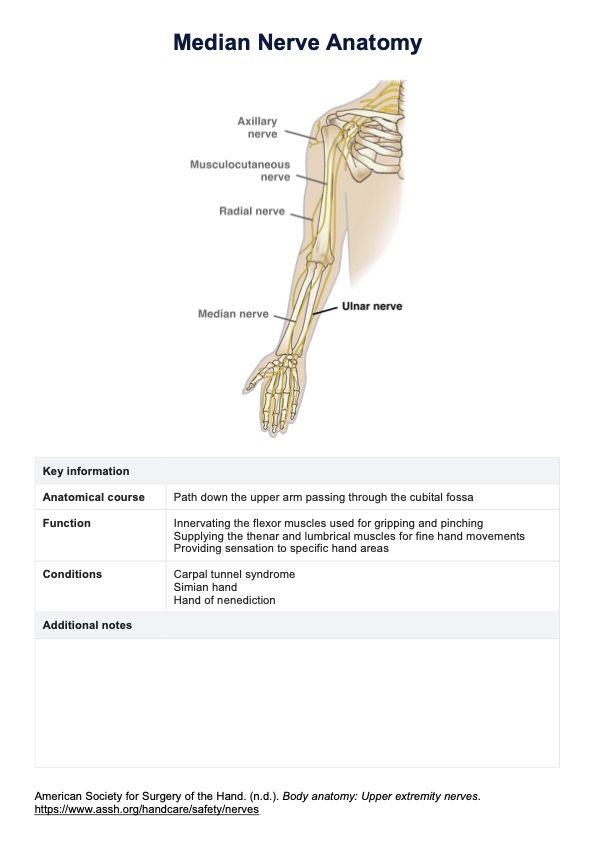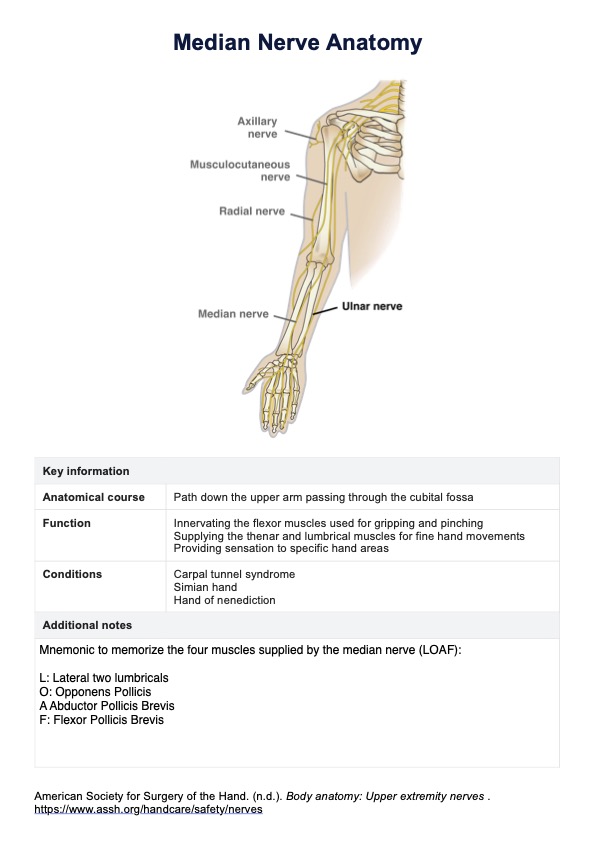Median Nerve Anatomy Diagram
Looking for a Median Nerve Anatomy Diagram for educational or clinical purposes? Click here to download our free template


Introduction
The median nerve is a crucial structure located in the upper limb. It has great clinical significance and serves three comprehensive functions: innervating the flexor muscles used for gripping and pinching with the thumb and index finger, supplying the thenar and lumbrical muscles for fine hand movements, and providing sensation to specific hand areas.
Medical students and healthcare professionals must understand the median nerve's anatomy to better diagnose and manage conditions like carpal tunnel syndrome, recognize deformities due to Simian Hand or Hand of Benediction, and guide surgical procedures and rehabilitation efforts.
Median Nerve Anatomy Diagram Template
Median Nerve Anatomy Diagram Example
How does our Median Nerve Anatomy Diagram work?
To help you master the median nerve anatomy, we created a Median Nerve Diagram Template you can download by clicking the button and using the links in this guide.
Follow our provided template by following our step-by-step instructions below on how to use our diagram template:
Step 1: Have a basic understanding
Start with a foundational understanding of the median nerve’s origin and course from the lateral and medial cords of the brachial plexus. Understanding the nerve roots and their contributions is essential for grasping the entire nerve structure.
Step 2: Study the anatomical course
Study the anatomical course of the median nerve, which is a path down the upper arm at the elbow joint, passing through the cubital fossa alongside the ulnar nerve and continuing into the forearm and hand.
Step 3: Understand the functional anatomy
Understand the muscles innervated by the median nerve, which are most forearm flexor muscles, thenar muscles, and lumbrical muscles. Also, it is important to recognize the role of the anterior interosseous nerve, which is connected to the median nerve, in controlling some of these muscles.
Finally, learn the sensory distribution areas of the median nerve, which include the palmar side of the thumb, index, middle, and part of the ring finger. The palmar cutaneous branch of the median nerve is crucial for this sensory innervation.
Step 4: Check clinical relevance
Familiarize yourself with common clinical conditions involving the median nerve and their clinical signs and symptoms, such as sensory deficits and motor dysfunctions affecting the index and middle fingers, thumb opposition, and grip strength. Understand how median nerve injury can lead to these conditions.
How will our diagram benefit healthcare professionals?
Median Nerve Anatomy diagrams are invaluable tools for healthcare professionals, enhancing their educational, clinical, communicative, and research capacities. Here's an overview of how it can benefit healthcare professionals:
- Visual aids and tools: Students and trainees can use the Median Nerve Anatomy Diagrams as visual aids to facilitate a comprehensive understanding of the median nerve. Clinicians can also use diagrams as visual tools to explain conditions related to the median nerve.
- Help identify crucial anatomical landmarks: In clinical practice, surgeons and clinicians rely on these diagrams during median nerve procedures. The diagrams help identify crucial anatomical landmarks, ensure precise incisions, and minimize surgical risks.
- Investigating anatomical variations and understanding nerve-related disorders: Median Nerve Anatomy diagrams are vital for researchers to investigate anatomical variations and understand nerve-related disorders.
Commonly asked questions
Most injuries of the median nerve happen at the wrist.
The median nerve gets pinched when it swells up within the carpal tunnel due to pressure.
When the median nerve is compressed, the patient may feel numbness, pain, or tingling often indicative of carpal tunnel syndrome.







































































































